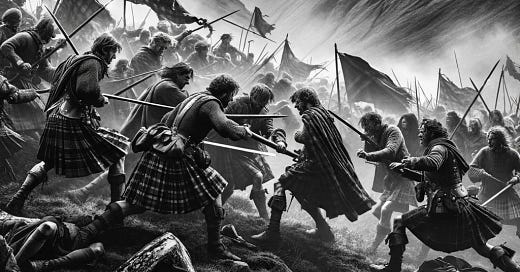The Johnston-Maxwell Conflict at Dryfe Sands
In the turbulent tapestry of Scottish history, where clan rivalries and power struggles painted a backdrop of relentless strife, the Battle of Dryfe Sands stands out as a significant conflict that not only shaped the destiny of the involved clans but also left an indelible mark on the feudal dynamics of Scotland. This battle, a culmination of long-standing feuds and power jostling, was fought between the Clan of Johnston and their formidable adversaries, the Maxwells of Nithsdale. The echoes of clashing steel and the cries of the warriors on that fateful day in December 1593 still resonate through the annals of Scottish history.
The Seeds of Conflict: A Rivalry Rooted in History
The roots of the conflict can be traced back to an intricate web of territorial claims, shifting alliances, and the unyielding desire of clan chieftains to assert their dominance. The Johnstons, under the robust leadership of their chief, Sir James Johnston, were a rising force, eager to carve out their supremacy in the volatile landscape of the Scottish Borders. In contrast, the Maxwells, led by their chief, Lord John Maxwell, were a well-established power, determined to defend their prestige and territories against the ambitions of their emerging rivals.
The landscape of the Scottish Borders, a patchwork of rugged hills, dense forests, and winding rivers, had long been a stage for the power plays of clans. It was not just the land that was divided, but also the loyalties of the people, who were often caught in the crossfire of their lords' ambitions. As the cold winds of December swept across this rugged terrain, the tension between the Johnstons and the Maxwells reached a boiling point. The spark that ignited this powder keg of animosity was the displacement of Lord Maxwell by Sir James Johnston from the influential position of Lord Warden of the West Marches. This role, pivotal in maintaining law and order in the region, was not just a position of power but also a symbol of royal trust and authority.
The Clash of Titans: The Battle Unfolds
The day of the battle dawned with grim foreboding. The forces of the Johnstons, though outnumbered, were galvanized by a fierce resolve to establish their might. The Maxwells, confident in their strength and historical dominance, were equally determined to quash the challenge to their authority. As the two armies converged at Dryfe Sands, the air was thick with anticipation and the grim recognition that the day would end in bloodshed.
The battle was fierce and unforgiving. The Johnstons, employing a combination of strategic prowess and indomitable spirit, managed to gain an upper hand early in the conflict. The Maxwells, caught off guard but far from defeated, fought with the valor and tenacity that were the hallmarks of Scottish clan warriors. The clash was not merely a contest of strength but a testament to the unyielding courage and resilience of the combatants.
The Price of Victory: The Aftermath of the Battle
As the sun dipped below the horizon, painting the skies with the somber hues of twilight, the outcome of the battle became clear. The Johnstons emerged victorious, their triumph marked by both the elation of victory and the somber realization of the cost at which it came. The Maxwells, though defeated, retreated with the dignity and resolve characteristic of a clan that had long been a cornerstone of Scottish nobility.
The field of Dryfe Sands, once a silent witness to the daily toils of the common folk, was transformed into a somber testament to the brutality of clan warfare. The ground, soaked with the blood of the fallen, bore the heavy burden of shattered dreams and broken families. In the days and weeks that followed, the community around Dryfe Sands grappled with the aftermath of the conflict, tending to the wounded, mourning the dead, and piecing together the fragments of a life disrupted by the chaos of war.
Echoes Through Time: The Legacy of Dryfe Sands
The Battle of Dryfe Sands was more than a mere conflict; it was a defining moment that reshaped the power dynamics of the Scottish Borders. It underscored the fragility of alliances, the transient nature of power, and the indomitable spirit of the Scottish clans that, even in the face of adversity, remained unbroken.
Today, the echoes of the battle linger in the collective memory of Scotland, a poignant reminder of a past marked by strife, valor, and an unyielding commitment to clan and kin. The legacy of the Battle of Dryfe Sands, impartial to the victor or the vanquished, remains a testament to the complex tapestry of Scottish history, woven with the threads of courage, ambition, and an indelible sense of identity.





